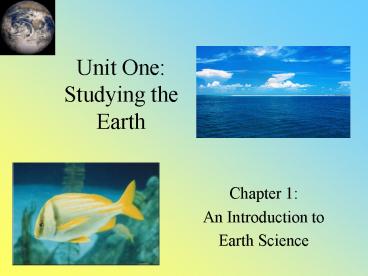Unit One: Studying the Earth - PowerPoint PPT Presentation
1 / 19
Title:
Unit One: Studying the Earth
Description:
Stonehenge in England. Nope! There we go!!! Branches of Earth Science ... Red shift. Doppler effect. The. Doppler Effect. Red and Blue Shifts. Same type of object ... – PowerPoint PPT presentation
Number of Views:72
Avg rating:3.0/5.0
Title: Unit One: Studying the Earth
1
Unit OneStudying the Earth
- Chapter 1
- An Introduction to
- Earth Science
2
What is Earth Science?
- The wonder of it all
- To try to explain the phenomena
- To record the events/cycles
- Inventions to help with observations
- and experiments
- The discipline of Earth Science was born!
3
Importance of Earth Science
- What earthly events would we like to know in
advance? - Which would we like to know more about?
- What would we like to know just for the sake of
knowledge?
4
Stonehenge in England
5
There we go!!!
Nope!
6
Branches of Earth Science
- Earth Science (ES) is the study of the earth and
the universe around it - Knowledge of ES has come from careful
observations and experimentation - Four main branches of ES
- Geology
- Oceanography
- Meteorology
- Astronomy
7
Branches of ES
8
Ecology
- Earth scientists study
- Geosphere the solid Earth
- Hydrosphere Earths water
- Atmosphere gases surrounding Earth
- ES Biology Ecology ? living things and how
they relate to their environment - Living things environment ecosystem
- A rotting log or an ocean any more?
- Biosphere the whole Earth
9
Dangers to our Biosphere
- Each ecosystem is delicately balanced
- Pollution
- Waste products
- Biodegradable vs. non-biodegradable
- Types of pollution
- Protecting the environment
- Example ozone hole
10
So, how do we know all this?
- Here we are! The place where you start in every
science class you will ever take!!! - Galileo is known (among many other great things)
as the Father of the Scientific Method - This guide helps scientists solve problems it
is not a step-by-step sequence that has to be
followed exactly for every experiment. - The key to this experimental guide is that the
process MUST be repeatable by another person.
11
Steps of the Scientific Method
- State the problem
- Gather info
- Form hypothesis
- Test hypothesis
- State conclusion
- Repeat work
12
What is a theory?
- Hypothesis (or set) that has been tested and
generally accepted - It is a result of experimentation and
observations - Provides a general explanation for observations
that is consistent with known facts - A well established theory may become a
- scientific law
- A law is a rule that describes a natural
phenomenon - A law must be proven correct EVERY time it is
tested
13
Birth of a TheoryThe Big Bang
14
All from a tiny
speck of light!
15
Light is a Mystery!
- Characteristics
- Behavior
- Newtons rainbow
and un-rainbow
16
More on light
- Spectroscope ?
- 3 Spectral types
- Continuous
- Bright-line
- Absorption
- Red shift
- Doppler effect
17
The Doppler Effect
18
Red and Blue Shifts
- Same type of object
19
(No Transcript)































